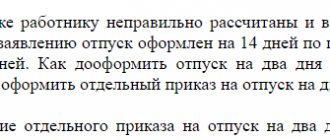New calculation of vacation pay in 2021, example of calculation
The basic procedure for calculating vacation pay for 2021 remains the same. It should also be based on the Decree of the Government of the Russian Federation No. 922. To calculate vacation pay, use the following formula:
O = SDZ x D,
Where:
O – the amount of vacation pay accrued to the employee;
SDZ – the amount of the employee’s average daily earnings;
D – number of vacation days.
In this case, the number of vacation days is determined based on the vacation order. Average earnings are calculated separately and depend on the amount of payments that were accrued to the employee during the billing period, as well as the number of days in the billing period.
The formula for calculating average earnings is as follows:
SDZ = V / Dr,
Where:
B – payments that are accrued to the employee for the billing period and are taken into account in the calculation;
Др – number of days in the billing period that are taken into account in the calculation.
Formula for calculating vacation pay
Now we move on to the most important thing - the full calculation of vacation pay. Vacation must be paid from average earnings for the entire pay period. An employee's average earnings are determined from the actual payments accrued to him and the time he worked over the last 12 months. At the same time, its operating mode does not in any way affect the average earnings.
The formula for an employee’s average earnings is calculated as follows: initially, his average daily earnings are determined. After this, the average daily earnings are multiplied by the total number of vacation days. Below is the formula for calculating vacation pay (Basic Formula):
| Vacation pay amount | = | Average daily earnings | X | Number of vacation days |
Now we’ll tell you in more detail how to calculate the average daily earnings. It will be equal to the ratio of the wages accrued for the billing period for the last 12 months to the average monthly number of days (which is 29.3). As we said above, all payments that were provided for by the company’s wage standards must be taken into account.
Payments during the absence of an employee are excluded from the total amount when:
- The employee retained his average salary in accordance with the laws of the country.
- The employee received benefits due to temporary disability.
- The employee was unable to work due to downtime caused by the employer himself.
- The employee did not take part in the strike, but could not work at this time.
- The employee was given additional paid time off.
As a result, we have the following formula for calculating average daily earnings:
| Average daily earnings | = | (Amount of accrued salary for the billing period / 12 months) | / | 29,3 |
Most often, it happens that using a simple formula it is impossible to calculate the average daily earnings, because over 12 months the employee was sick or was on vacation because he divided it into several parts.
Now we will consider the case where the employee worked for less than 12 months. As happens most often. So, if one or a couple of months from the reporting period, the employee did not work fully, then the average daily earnings will be calculated by dividing the amount of actually accrued wages for the billing period by the sum of the average monthly number of calendar days (29.3), multiplied by the total number of full calendar days days and the number of calendar days in incomplete calendar months. It’s best to break this huge formula down into a couple of simple ones:
First, let's calculate the average daily earnings:
| Avg. daily earnings | = | Accrued payments | / | Number of days per billing period |
In order to find the total number of days for the billing period, you must:
| Number of days per billing period | = | Days from full months | + | Days from partial months |
To find days from full months you need:
| Days from full months | = | number of full months | X | 29,3 |
And the last thing, but also the most difficult to calculate, is to count days from incomplete months:
| Days from partial months | = | (29.3 / number of calendar days of this month) | / | number of days that fall within the time worked |
↑ to contents
How to calculate and charge taxes on vacation pay
It is worth remembering that when paying vacation funds to an employee, you must pay the amount of personal income tax. This rule is specified in paragraph 1 of Article 226 of the Tax Code of the Russian Federation. Vacation pay is subject to personal income tax and insurance contributions. Today, the personal income tax rate is 13 percent. The company is required to withhold this amount of tax from the employee’s income. The company is obliged to transfer this tax no later than the day of actual receipt of cash from the bank for the payment of vacation pay.
As for the tariffs for insurance premiums, they directly depend on whether the total amount of payment to the employee exceeds the limit of 624 thousand rubles. If the employee’s activities are in no way connected with the acquisition or creation of fixed assets, then in this case the total amount of vacation payments will be recognized as a labor expense for profit tax purposes.
↑ to contents
New calculation of vacation pay in 2021. Billing period
The billing period refers to the time for which payments to the employee are taken into account.
The billing period is taken to be one of the following periods:
- Standard, that is, the 12 months preceding the month in which the employee goes on vacation;
- Special, when the standard period is replaced by another period, which the employer has the right to choose at his own discretion.
Important! To calculate vacation pay, payments for the standard pay period or for a special period are taken into account.
The standard period depends on the month in which the employee’s vacation begins. In this case, the month in which the employee goes on vacation is not taken into account, and the month from which the billing period begins is taken as the month that precedes the start of the vacation (
What is it needed for?
It is impossible to do without the coefficient; it shows the average number of days in a month and is needed for the correct calculation of the amount of average daily earnings for vacation pay and compensation, as well as for the correct calculation of days in an incomplete working period.
The period for calculating average earnings is the year before the month of going on vacation (clause 4 of the Regulations).
Only days of performance of labor functions are taken into account, even if the employee went to work on red days in the calendar or holidays.
Work experience does not include days of treatment, past vacations, business trips, days off, etc. (clause 5 of the Regulations).
In 2021, for each full month of work, the established coefficient is taken - 29.3.
If the work was not carried out for the entire monthly period, then another norm is applied (clause 10 of the Regulations), a calculation is made taking into account the calendar days worked and the total days of the period, followed by multiplication by the average number of days. Explanations are given below using examples.
The basis for calculating the entire amount due when applying for vacation pay includes all labor charges and bonuses. Certificates of incapacity for work, business trips, and financial assistance are not taken into account.
Application during full period of work
If the entire base period was devoted to work, and all months of the billing period were worked in full, then you should look at paragraph 10 of the Regulations and substitute the values into the given formula to calculate the average salary per day for vacation pay, taking into account the current coefficient 29.3.
Formula:
SDZ = Amount of payments / (12 months x 29.3)
A month is considered fully worked if it did not include:
- sick leave;
- business trips;
- vacations of any type;
- absence and withdrawal.
That is, in this case it is considered that in each of the 12 months of the billing period the person worked 29.3 days.
The total number of days actually worked for a fully worked year = 12 months. * 29.3 = 351.6
How to calculate if the month is incomplete?
Coefficient 29.3 is also necessary when calculating average earnings for vacation pay in cases where the employee has not worked out the entire pay period. In this case, the actual operating time is calculated in calendar days, taking into account the coefficient of the average monthly number of days.
If the base period has not been fully worked out (that is, there are monthly periods that have not been fully worked out), or there are days that are not taken into account, then you should be guided by the following formulas (clause 10 of the Regulations):
Formula:
SDZ = Amount of payments / (29.3 x Number of full months + Days in partial months).
To determine the average salary for vacation pay, you need to know the number of days worked in partial months; for this, the following calculation is used:
Formula:
Days in an incomplete month = Number of calendar days worked x 29.3 / Total number of calendar days in the month.
Vacation pay should be calculated as follows:
Formula:
Vacation pay = SDZ x Vacation days.
Calculation example
Example conditions:
- It is planned to provide rest days from 07/01/2019 for 28 calendar days.
- The period for calculation is from 07/01/2018 to 06/30/2019.
- Monthly salary – 30,000 rubles.
- There is a certificate of incapacity for work - from 03/10/2019 to 03/18/2019.
- Salary in March - 20,000 rubles.
Calculation of vacation pay using coefficient 29.3:
- The amount of total payments (which are taken into account) = 350,000 (30,000 x 11 + 20,000).
- Complete days = 322.30 (29.3 x 11).
- Partial days = 20.79 (22 x 29.3 / 31).
- Average earnings for 1 day = 1020.14 (350,000 rubles / (322.30 + 20.79).
- Average earnings (total) = 28,563.92 rubles (1,020.14 x 28)
Please note: What to do if a regional coefficient is established in the region, how to take it into account in vacation pay?
New calculation of vacation pay in 2021. Number of days in the billing period
Now you need to determine the number of days that need to be taken into account in the billing period.
If there were excluded days in the billing period, then the number of days is calculated as the sum of the number of days in fully worked months and the number of days taken into account in months not fully worked.
A month worked in full is taken to be a month in which there are no excluded days from the first to the last.
The number of days in fully worked months is calculated as follows: the number of fully worked months is multiplied by 29.3 (the average monthly number of calendar days).
The calculation of days in months worked is not fully calculated as follows: 29.3 is divided by the number of days in that month (that is, 28, 30, 31 or 29 if it is a leap year) and multiplied by the number of days worked in that month.
The number of days worked is calculated as the total number of days in this month minus the excluded days.
Important! Weekends falling during excluded periods are not taken into account, and all other weekends are classified as days worked.
Who is entitled to leave?
The right to take annual leave arises for an employee after six months of working for a given employer. If the parties to the contract reach an agreement, the leave may be granted earlier.
If an employee quits without working for even six months, the employer is obliged to pay him compensation for unused vacation days. The formula for calculating vacation pay is not that complicated. You need to know which periods are taken into account for the length of service that gives you the right to leave.
Starting from the 2nd year of fulfilling his labor duties, the employee’s vacation is provided in accordance with the schedule, which must be approved at each enterprise before December 15 of the current year for the next year. Every employee should be familiar with the methodology for calculating vacation pay.
Vacation pay is calculated using the formula
OTP = (Salary / (12 * 29.3))* number of vacation days, where
- OTP - the amount of compensation received for vacation.
- Salary is the salary of a given employee for the entire period worked; 12 is the number of months in a year.
- 29.3 – average number of days in a month. This value is set at the Government level.
Calculation and payment of vacation pay must be made no later than 3 calendar days before the start of the employee’s vacation. It is more difficult to use the above formula if the employee has not completed a full working year.
To calculate how many vacation days a given employee has earned, you must use the formula
(29.3 / 12) * total number of months worked. 29.3 / 12 = 2.44 days each employee has for the month actually worked.
New calculation of vacation pay in 2021. Duration of vacation
The usual length of leave is 28 days. In this case, the employee, having agreed on his wishes with the employer, has the right to divide his vacation into several parts. It is important to remember that one of these parts must be at least 14 days (Read also the article ⇒ Vacation in working days in 2021 (an example of calculating vacation in working days)).
Vacation is counted in calendar days, and it does not matter whether weekends fall within this period.
Important! An employee can extend his vacation only due to holidays that fall during his vacation period.
The procedure for calculating vacation pay on holidays
The amount of accrued vacation pay must be included in expenses in proportion to the vacation days that occurred in each reporting period. The amount of accrued vacation pay for annual paid vacation is included in income tax expenses in proportion to the vacation days falling on each reporting period.
Expenses for profit tax purposes are recognized in the reporting period to which they relate and do not depend on the time of actual payment of funds. The date of expenses in the form of insurance premiums is the date of their accrual. (Letter of the Ministry of Finance No. 03-03-РЗ/27643)
The duration of the annual basic paid leave is calculated in calendar days. Weekends, just like working days, must be included in the number of calendar days of vacation.
Part one of Article 112 of the Labor Code of the Russian Federation establishes the following non-working holidays on the territory of the Russian Federation
- January 1, 2, 3, 4, 5, 6, 7, 8 — New Year holidays.
- January 7—Christmas Day.
- February 23 is Defender of the Fatherland Day.
- March 8 is International Women's Day.
- May 1 - Spring and Labor Day.
- May 9 is Victory Day.
- June 12 is Russia Day.
- November 4 is National Unity Day.
In cases where holidays occur during the vacation, the end date of the vacation is postponed by the number of days that corresponds to the number of days of holidays.
Comment
Tell me, what do you think about this?
New calculation of vacation pay in 2021, example of calculation
Example #1
Let's consider an example when an employee worked all 12 months in the billing period:
Petrova O.P. I wrote an application for leave from March 1 to March 28, 2018. Petrova’s salary is 45,000 rubles, the monthly bonus is 5,000 rubles.
We determine the billing period: from March 1, 2021 to February 28, 2018.
Let's calculate the average earnings: (45,000 + 5,000) x 12 / 12 = 50,000 rubles.
Vacation pay will be as follows: 50,000 / 29.3 x 28 = 47,781.51 rubles.
Petrova will receive vacation pay minus personal income tax, that is, 41,569.97 rubles
Example #2
Now let’s look at an example when the employee’s billing period has not been fully worked out:
Ivanov I.I. got a job on October 10, 2021. He wrote an application for leave for 14 days from May 14 to May 27, 2021. Upon employment, Ivanov was given a salary of 40,000 rubles for a probationary period of three months. After the probationary period, Ivanov was given a monthly bonus of 5,000 rubles.
We determine the billing period: from October 10, 2021 to April 30, 2018. At the same time, we divide the taken period into months worked completely and partially. Ivanov worked completely for 6 months from November 2021 to April 2021, that is: 6 months x 29.3 = 175.8 days
In October 2021, Ivanov did not work a full month, that is, we exclude 9 days from it: 29.3 x 20/30 = 19.53 days
Total number of days: 175.8 + 19.53 = 195.33 days
Let's calculate the average earnings: (26,666.67 + 2 x 40,000 + 4 x 45,000) / 195.33 = 286,666.67/195.33 = 1,467.60 rubles
Vacation pay will be: 1,467.60 x 14 = 20,546.40 rubles
Ivanov will receive 17,875.37 rubles in his hands
Example #3
Let's consider an example when an employee was paid a quarterly bonus for the time worked.
Petrov P.P. got a job on September 1, 2021. Based on the results of the 4th quarter of 2021, Petrov was paid a bonus in January 2021 equal to 12,000 rubles. Petrov's salary is 40,000 rubles. Petrov wrote an application for leave for 14 days from July 10, 2018.
We determine the billing period: from September 1, 2021 to June 30, 2018.
Petrov’s bonus was awarded for the last three months of 2021; accordingly, the bonus is included in the calculation in full.
Let's calculate earnings: 40,000 x 10 + 12,000 = 412,000 rubles
Let's calculate the average daily earnings: 412,000 / 10 / 29.3 = 1,406.14 rubles
Vacation pay: 1,406.14 x 14 = 19,685.96 rubles
Petrov will receive 17,126.79 rubles in his hands
Which one to use in 2021 - 29.3 or 29.4?
Within the meaning of the provisions of Article 139 of the Labor Code, it was established that the average salary of an employee per day is determined by dividing the amount of total accrued wages by 12 and by a coefficient of 29.3 (the number of calendar days on average per month).
The new norm came into effect on April 2, 2014, when the coefficient 29.4 was replaced by 29.3 when calculating vacation pay and vacation compensation.
The average wage per day is the main figure when making vacation payments and calculating compensation for unused rest days upon dismissal.
After the introduction of the new rules, a problem arose with the use of the Regulations on the calculation of average wages, since the calculation procedure remained the same.
According to the previously valid rules, that is, before the date - 04/2/2014, the coefficient of the average monthly number of days was applied - 29.4. In this case, the letter of the federal law had the greatest legal force, so the norms of the labor code were used in the work.
Later, this document was amended by Government Decree No. 642 of July 10, 2014, which brought all the standards into compliance.
You can calculate your vacation pay using the online calculator here.
Simple, convenient and free calculator.
Determining the billing period
According to current principles, calculations are made based on data taken for 12 full months preceding the date of rest. For example, if a specialist took a vacation in October 2018, the time interval from 10/01/17 to 09/31/18 is taken as the basis for calculations.
In practice, non-standard situations are possible when other rules apply on how to calculate the average salary for vacation pay:
| Special cases of calculation | A comment |
| The specialist joined the company less than a year ago. | Calculations are made for the actual time worked. |
| The citizen, in agreement with his superiors, took a vacation during the month of employment. | Calculation is carried out for actually worked days. |
| The employee did not work during the previous 12 months and did not receive a salary (for example, he was on “children’s” leave). | Calculations are carried out for the year in which he was paid his salary. |
Now let's talk about how to calculate vacation pay if there is no average earnings. That is, if a citizen in fact never worked in an organization (he was simply retained a place)? The basis for calculations is the tariff rate indicated in the employment contract.
Violation of deadlines for payment of vacation pay
Failure to comply with the established deadline for paying for the next vacation is punishable by a fine. And if this violation is recorded by a labor inspector, then you will have to bear responsibility for it. So, clause 1st. 5.27 of the Code of Administrative Offenses of the Russian Federation provides for fines:
- for enterprises – from 30,000 to 50,000 rubles;
- for officials (for example, personnel officer, accountant, company director) - from 1000 to 5000 rubles;
- for a businessman-individual entrepreneur – from 1000 to 5000 rubles.
However, in the event of a single violation detected for the first time, the inspector, as a rule, confines himself to a warning. If non-compliance with labor legislation is systematic, and the company has already been given administrative responsibility, repeated sanctions by the State Labor Inspectorate are tightened, and fines increase significantly, amounting to:
- for companies – from 50,000 to 70,000 rubles;
- for officials – from 10,000 to 20,000 rubles. or disqualification for a period of 1 to 3 years;
- for individual entrepreneurs – from 10,000 to 20,000 rubles.
Let us note that the employer will violate the deadlines for issuing vacation pay even if he urgently releases an employee based on an application with motivated circumstances, written later than 3 days before the start of the vacation, since there are no exceptions in Art. 136 of the Labor Code of the Russian Federation is not provided for (letter of the Ministry of Labor of the Russian Federation No. 14-2/B-644 dated August 26, 2015).







